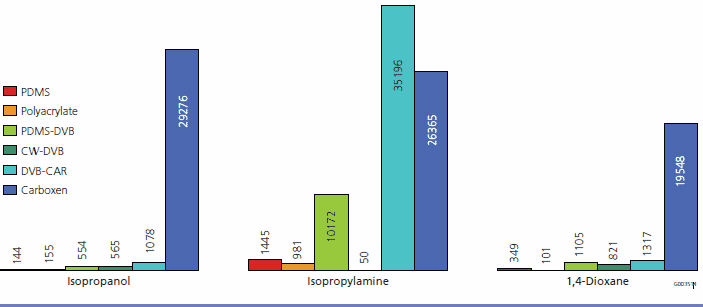Developing a Quantitative SPME Method
Robert Shirey
Reporter EU Volume 22
Analysts routinely use SPME as a qualitative extraction tool but are reluctant to use it for quantification because analytes are not exhaustively extracted. Numerous publications have shown that SPME can quantify samples if good procedures are followed. This study will show how to quantify the extraction of 1,4-dioxane using SPME.
Dioxane is commonly used as a stabiliser in chlorinated organic solvents, primarily 1,1,1- trichloroethane (TCA). It is also used as an industrial solvent in the cosmetic, paint and pharmaceutical industries. Dioxane is highly water soluble, not easily hydrolyzed or biodegraded, and is included on the US EPA list of potential carcinogens. The extraction of dioxane is difficult because of its solubility in water.
To properly quantify a sample using SPME, there are certain guidelines and steps to follow. This procedure was used to determine how to quantitatively extract dioxane from water.
- Determine conditions for analysis of dioxane by preferred analytical technique (GC-MS)
- Determine appropriate internal standard
- Select appropriate fiber
- Determine extraction mode
- Determine optimum extraction conditions
- Time
- Temperature
- Determine effect of sample modification
- Determine detection limits and linear range
- Reproducibility of fibers
A column with a thick film was used to assure that dioxane is properly focused. The longer length provides adequate backpressure for the flow to be controlled under vacuum.
Choose internal standards that are similar to the analytes in both properties and extraction characteristics. When detecting with mass spec, deuterated analytes make the best internal standards and should be used if possible. For other detectors a good test is to change extraction conditions. If the relative response remains constant, then the internal standard is behaving similarly. For this study, dioxane-d8 was used. Isopropanol is a good internal standard for dioxane with other detectors.
Figure 1 shows that Carboxen™ PDMS coated metal fibers extract 100-300 times as much as other SPME fibers. The small pores in Carboxen 1006 are ideal for retaining low molecular weight analytes.

Figure 1.Area Response by Fiber Type
Determination of Extraction Mode, Temperature, Time and Sample Modification
Extraction of samples using SPME can be accomplished by directly immersing the fiber into the sample or by placing the fiber in the headspace above the sample. Agitation is usually used with SPME, but in some cases it may not be necessary. When using headspace SPME, the temperature of the sample during extraction is important. Figure 2 shows the comparison of the extraction of dioxane by immersion of the fiber and by headspace exposure with the sample temperature at ambient and at 55 °C. The results clearly show that heated headspace with agitation at 55 °C is the best extraction condition for this analyte. Although not shown here, detailed results of the optimisation of extraction time and temperature are available in a Supelco presentation. Request T406024 (available only as pdf file, please provide your e-mail address).

Figure 2.Dioxane Response versus Extraction Time
Modifying the sample can greatly enhance sample recovery. In this study 25% NaCl was added to the water samples. Dioxane does not appear to be affected by pH within the range for SPME use of 2-11.
It is also important to determine the linear range for your method. The fiber may have greater capacity than the detector, so the entire method must be evaluated. It is best to prepare a stock solution of buffered salt water and spike samples of the water with the analytes of interest at various concentration levels, while keeping the internal standard at a fixed concentration.
Extract the samples using the optimised conditions and calculate response factors for the analytes. Since response factors account for concentration, the number should remain consistent. When the response factor increases 3 sigma, that is the end point of the linear range. The analyte response can be plotted and linear regression can be applied to evaluate the range and set detection limits.
Figure 3 shows the results for dioxane. By subtracting the area counts of extracted blank samples, the detection limit can be lowered to 0.5 ppb. In this study the upper limit was 100 ppb.

Figure 3.Dioxane Response versus Concentration
Conclusions
This study developed guidelines for developing a method using SPME for the quantitative extraction of dioxane using a Carboxen-PDMS fiber. The method shows the importance of choosing the appropriate fiber, internal standard and extraction technique. In addition, the method shows how a sample can be modified to enhance extraction recovery.
In this study, dioxane was extracted down to 0.5 ppb and was linear through 100 ppb. This study determined that the new metal Carboxen SPME fibers are reproducible by evaluating 10 fibers with under 11% relative standard deviation. With the use of an internal standard, the %RSD of the relative responses between fibers was only 3.5%.
To continue reading please sign in or create an account.
Don't Have An Account?